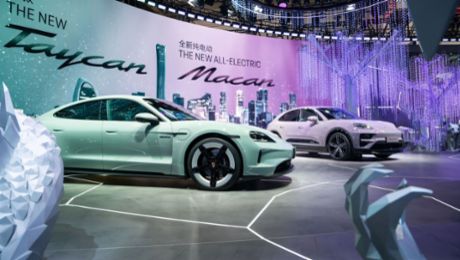When it comes to charging, Porsche customers benefit from the model line’s extensive updates in several respects: the updated Taycan requires even fewer charging stops than its predecessor, and it charges both faster and more stably at home or at a charging station. To put it in numbers: depending on the body variant and engine, the WLTP range has increased to up to 678 km, an increase of 175 km or 35 per cent.
The updated Taycan not only requires fewer charging stops than its predecessor, but it also recharges faster: at 800-volt DC charging stations, for example, it can be charged at up to 320 kW. That’s 50 kW more than before. With greater charging stability, high charging capacities of more than 300 kW can be sustained for up to five minutes. This reduces the charging time from a ten to 80 per cent State of Charge (SoC) by just under four minutes to 18 minutes, despite a 12 per cent increase in battery capacity.
Shorter charging times thanks to new charging architecture
In addition to the high-performance battery, Porsche has also significantly upgraded the charging architecture. The newly developed Combined Booster Charger (CBC) replaces the DC/DC converter and the first-generation HV booster. Its newly developed power modules and optimised cooling enable up to 320 kW of charging power at 800-volt charging stations – 50 kW more than in its predecessor. Charging at up to 150 kW is possible at 400-volt charging points. The charging time there is about 35 minutes.
The CBC also contains a Power Distribution Unit (PDU). This acts as an interface to the DC charging infrastructure and is used as a traction grid distributor in the front end during charging.
The standard on-board eleven kW AC charger has a new controller for a more robust charging process. The new software also initiates the relevant communication with the charging station much faster and authorises the charging process more swiftly as a result.
Now standard on all Taycan models: the Electric Charging Cover
The Electric Charging Cover now comes standard. As before, it can be locked and unlocked from the outside in a sensor-controlled manner with a hand gesture or operated from the interior via the control panel on the centre console. The modified charging socket makes it easier to lock and unlock the charging plug. When the plug is removed, the Electric Charging Cover closes automatically. The charge port door is designed to remain functional even in ice and snow.
The charging socket is illuminated, which makes it easier to operate when visibility is poor. A display in the charge port door provides information about the charging process. The now eight display modes also include those for initialisation of charging and interruptions to the charging process.
Faster route planning and a clearer structure: Porsche Charging Planner
The Porsche Charging Planner helps Taycan drivers plan charging stops and takes traffic volume, driving time and charging time along the route into account. The calculation is now performed online by default. This makes it three times faster than its predecessors. If there is no connectivity, the calculation is carried out offline in the vehicle. The route optimisation setting in Range driving mode can also be set directly in the Charging Planner menu. In the ‘Assisted driving’ and ‘Limiter’ assistance modes, the determined maximum travel speed is automatically taken into account.
The Charging Planner also plays a central role in fast charging. With active route guidance, it better prepares the battery for the upcoming charging process.
The Charging Planner is now more clearly structured. For example, drivers can now preselect the desired minimum charge level at the destination in the route monitor in the map view. The setting is made using a virtual slider on the central display. When planning routes, it is possible to prioritise or exclude or ‘blacklist’ certain charging points based on criteria such as charging capacity and plug and charge capability of the charging stations. In future, charging stations with multiple fast chargers with a charging capacity of more than 150 kW will be automatically prioritised in route planning.
The latest version of the Charging Planner also includes more extensive information on points of interest (POI). For example, information is provided on how long the charging points are open and whether toilets and restaurants are available at the charging stop. The number of free stations is also displayed.
The plug and charge function continues to offer great charging convenience. The driver simply has to plug in the charging cable at suitable charging points and make sure that the plug is locked. The Taycan handles authentication, charging start and payment by communicating with the charging system using certificates installed in the vehicle.
About the Porsche Charging Service
The Porsche Charging Service enables access to the charging points of a range of providers all over the world. Currently, almost 600,000 charging points are connected in Europe in 24 countries. This includes about 35,000 charging points of 150 kW or higher charging power. And almost 600 fast-charging sites in the IONITY network in Europe. Last year, Porsche participated in a further round of financing for this joint venture.
Porsche is also planning to build its own fast charging stations along the major European transport routes, offering a brand-appropriate charging experience. The first Porsche Charging Lounge at Bingen am Rhein in Germany opened as a pilot site in the summer of 2023: just two minutes from motorway junction A60/A61, it offers six 300 kW DC fast-charging stations and four 22 kW AC charging points. Further Porsche Charging Lounges are currently planned for Germany, Austria and Switzerland.
More than 845 Porsche dealer locations have also made a tangible contribution to the expansion of the global charging infrastructure network. More than 1,500 high-performance charging points have been put into operation for customers there so far. China has an exclusive network with almost 300 charging points. In co-operation with various partners, more than 400 of these charging points have also been implemented in, for example, Spain, Italy, Korea, Japan and Brazil. In the US, Porsche uses the Electrify America network. They currently offer upwards of 3,500 fast-charging points at more than 800 stations.
Porsche is also further expanding the infrastructure for AC charging – with Porsche Destination Charging. There are already more than 5,000 charging points in 86 countries, at luxury destinations particularly popular with Porsche customers. By the end of 2025, this number is expected to exceed 7,500. Chargers providing 22 kW instead of eleven kW are already being used at new locations in Europe. Existing stations will be gradually upgraded.


